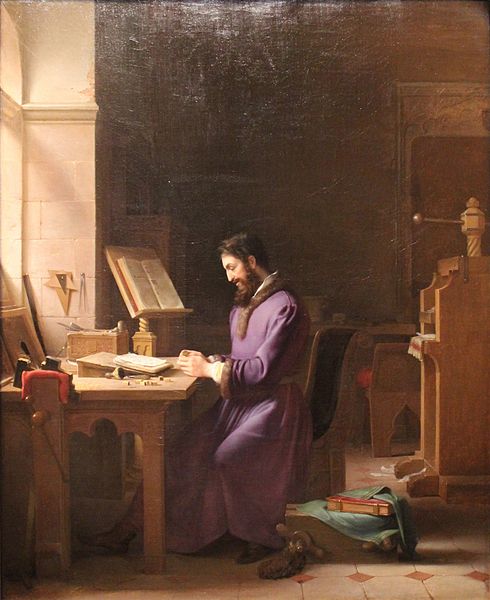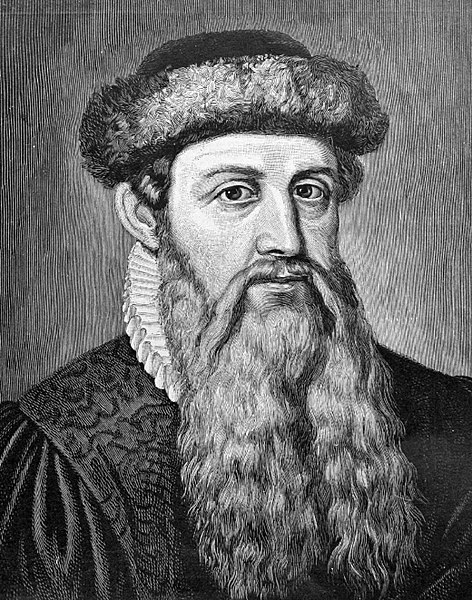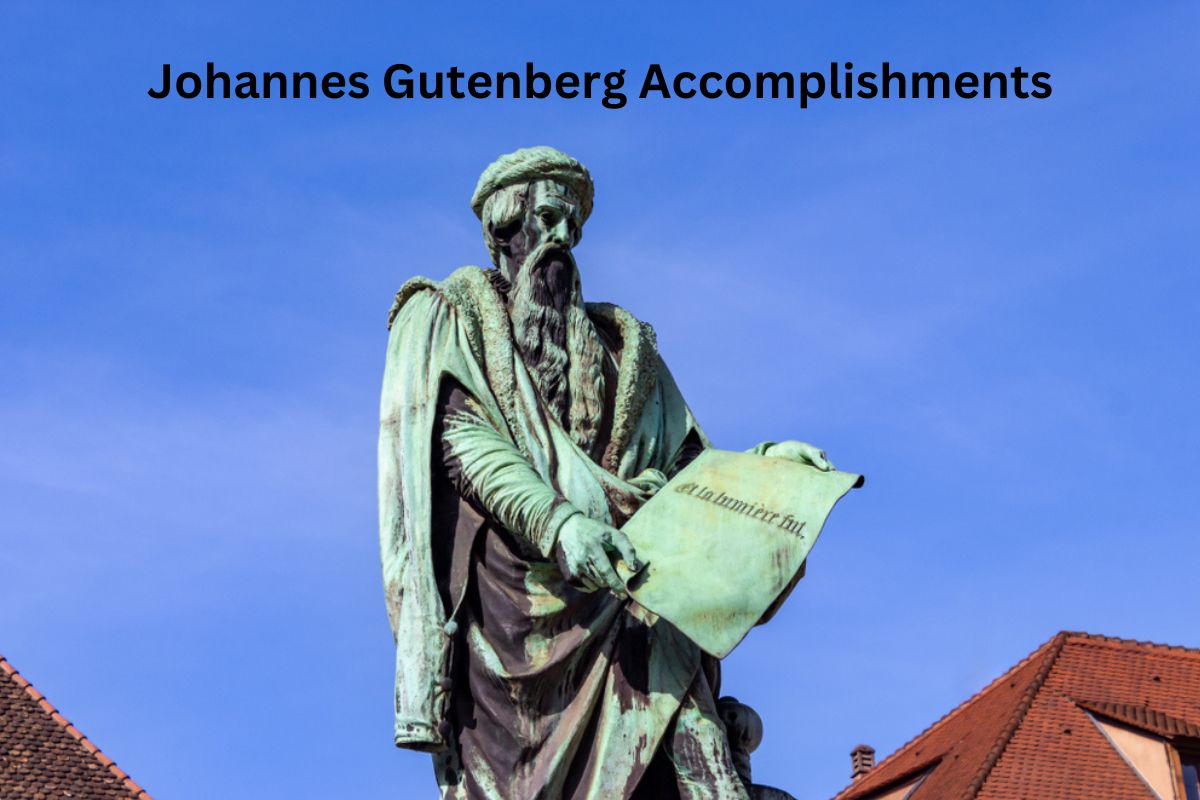Johannes Gutenberg (c. 1400 – February 3, 1468) was a German inventor and blacksmith known for his groundbreaking invention of the mechanical movable-type printing press.
Born in Mainz, Germany, Gutenberg’s invention revolutionized the world of publishing and significantly impacted the spread of knowledge during the Renaissance.
His most famous work, the Gutenberg Bible, marked the beginning of mass-produced books in the 15th century.
Gutenberg’s printing press made literature and information more accessible, contributing to increased literacy rates and cultural advancement.
His legacy endures as he is widely regarded as one of the most influential figures in the history of printing and communication.
Accomplishments of Johannes Gutenberg
1. Invention of the Printing Press
Johannes Gutenberg’s most groundbreaking achievement was the invention of the mechanical movable-type printing press around 1440. This invention completely transformed the way information was disseminated.
Before the printing press, books and documents were painstakingly copied by hand, which was a slow and error-prone process. Gutenberg’s press, however, allowed for the mass production of books and other printed materials.
Also Read: Facts About Johannes Gutenberg
It consisted of movable metal type, an ink-based printing system, and a press that could produce multiple copies of a text with remarkable speed and accuracy. This innovation revolutionized the world of publishing and is often credited with sparking the “Printing Revolution.”

2. Movable Type
One of Gutenberg’s key innovations was the development of movable type. This involved creating individual metal characters (letters, numbers, punctuation marks) that could be arranged and rearranged to compose different texts.
Also Read: Timeline of Johannes Gutenberg
Prior to this, most printing methods used fixed wooden or metal blocks for each page, making customization and corrections challenging and time-consuming. Movable type allowed for greater flexibility in printing and made it easier to adapt the press for different languages and texts.
Gutenberg’s movable type system was a critical component of his printing press and became a model for future printing technologies.
3. Gutenberg Bible
Perhaps the most famous book to come off of Gutenberg’s printing press is the Gutenberg Bible, also known as the 42-line Bible or the Mazarin Bible.
This Bible was printed around 1455 and is considered one of the earliest major books printed using movable type. It’s renowned not only for its historical significance but also for its exceptional craftsmanship.
The Gutenberg Bible played a pivotal role in the dissemination of religious texts and helped to set a high standard for the quality of printed books.
Today, surviving copies of the Gutenberg Bible are highly prized as rare and valuable artifacts, showcasing Gutenberg’s mastery of the printing process and typography.
4. Mass Production of Book
One of the most profound impacts of Johannes Gutenberg’s invention of the printing press was its ability to facilitate the mass production of books.
Prior to the printing press, books were copied by hand, a laborious and time-consuming process that limited the number of books in existence. Gutenberg’s press changed this dramatically. With movable type and his press, he could produce multiple copies of a book with relative ease and speed.
This made books more widely available and affordable, opening up access to knowledge and literature to a much broader segment of society. As a result, the spread of information and ideas accelerated, contributing to the intellectual and cultural flourishing of the Renaissance and beyond.

5. Standardization of Fonts
Gutenberg’s printing press also introduced the concept of standardized fonts and typefaces. Before his time, the appearance of printed text varied widely because printers often created their own unique typefaces.
Gutenberg, on the other hand, developed a consistent set of typefaces for his press. This standardization not only made printed material more legible but also improved the overall aesthetics of printed documents.
It set a precedent for future printers to create consistent, recognizable fonts, which remains a fundamental aspect of typography in modern publishing.
6. Increased Literacy Rates
The mass production of books and the accessibility they offered had a direct impact on literacy rates. Prior to the printing press, literacy was limited to a small elite class, primarily religious leaders and scholars who had access to handwritten manuscripts.
The availability of printed books made reading and education more attainable for a broader population. As books became more affordable and widespread, people from various social and economic backgrounds had the opportunity to learn to read and acquire knowledge.
This expansion of literacy had far-reaching consequences, not only for individual empowerment but also for the advancement of societies and cultures.
7. Preservation of Knowledge
Gutenberg’s invention of the printing press played a crucial role in preserving knowledge. Before the advent of printing, important texts and manuscripts were often stored in monasteries, libraries, or private collections.
These handwritten documents were susceptible to damage, decay, and loss. Gutenberg’s press enabled the replication of such texts with precision and speed.
As a result, many valuable works were saved from obscurity and potential extinction. This preservation of knowledge was essential in safeguarding cultural, historical, and scientific information for future generations.
8. Influence on the Renaissance
Gutenberg’s printing press had a profound impact on the Renaissance, a period of cultural and intellectual revival in Europe. The rapid dissemination of classical texts, scientific discoveries, and artistic works made possible by the printing press fueled the intellectual ferment of the era.
Renaissance thinkers, artists, and scholars had access to a wealth of knowledge that inspired new ideas and innovations across various disciplines.
Gutenberg’s press can be seen as a catalyst for the Renaissance, contributing to the rebirth of learning and creativity during this pivotal period in history.
9. Spread of Information
Beyond religious texts and classic literature, Gutenberg’s press printed a wide range of materials, including scientific treatises, political pamphlets, and news articles. This expanded the scope of information available to the public and fostered a culture of information-sharing.
The press enabled the rapid distribution of news and ideas, leading to the birth of journalism and a more informed and engaged citizenry. The concept of public discourse and the exchange of ideas became more accessible and influential due to Gutenberg’s innovation.
10. Printing Industry Legacy
Gutenberg’s invention laid the foundation for the modern printing and publishing industry. It established key principles of printing technology, including movable type and the use of printing presses, that continue to influence the industry today.
The development of new printing techniques and technologies over the centuries, such as steam-powered presses and digital printing, can be traced back to Gutenberg’s initial innovations.
The printing and publishing industry remains a cornerstone of the global economy, shaping the way information is created, disseminated, and consumed in the contemporary world.
